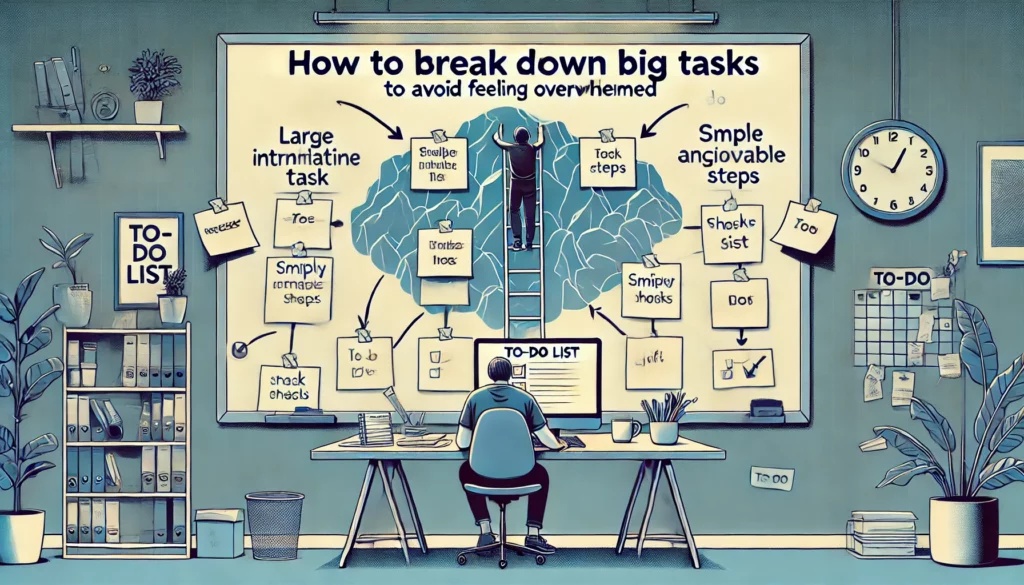Big tasks have a way of making us freeze. Whether it’s writing a research paper, preparing for a big presentation, or launching a new project, the sheer size of the task can trigger stress, procrastination, and mental fatigue.
But here’s the secret: you don’t need to tackle the entire project all at once. When you break a large task into smaller, more manageable parts, it becomes less intimidating and far more doable. This simple strategy turns overwhelming projects into achievable steps—and gives you the momentum to actually start and keep going.
In this article, you’ll learn how to break down large tasks effectively, so you can stop overthinking and start making progress.
Why Big Tasks Often Lead to Procrastination
When your brain sees a task as vague, complex, or time-consuming, it tries to protect you from discomfort by avoiding it. This often results in:
- Delaying the task indefinitely
- Overanalyzing instead of acting
- Feeling stuck before you even begin
Breaking the task down helps reduce the mental resistance. It turns one intimidating goal into a series of approachable actions that are easier to start and complete.
Step-by-Step: How to Break Down Big Tasks
1. Define What “Done” Looks Like
Before breaking the task into smaller parts, clarify exactly what success means. The more specific your goal, the easier it is to plan for it.
Examples:
- Instead of “Write a paper,” say “Write a 10-page research paper on climate change with at least 5 sources.”
- Instead of “Get fit,” say “Work out three times a week and lose 5kg in three months.”
- Instead of “Learn French,” say “Hold a basic conversation and memorize 500 common words in six months.”
A clear outcome gives your brain a target—and makes each step more purposeful.
2. Break the Task Into Major Milestones
Once you have a clear goal, identify the big checkpoints you’ll need to hit along the way. These are the key phases of your project.
Example for writing a book:
- Outline chapters
- Write first drafts
- Edit and revise content
- Format and finalize for publication
Each milestone gives you direction and makes the overall goal feel less distant.
3. Turn Milestones Into Actionable Steps
Now break each milestone into tasks that are small enough to complete in a single session. The goal here is to make every task feel so simple that starting is no longer intimidating.
Example:
- Research supporting data
- Write a rough outline
- Write 500 words
- Write another 500 words
- Review and make edits
These bite-sized tasks help you stay focused and build steady momentum.
4. Use the Two-Minute Rule to Start Instantly
One of the hardest parts of any big task is just getting started. The Two-Minute Rule helps you bypass hesitation by telling your brain, “I’m only committing to two minutes.”
Examples:
- Open the document and write the first sentence
- Read one paragraph from your study material
- Do two minutes of stretching or light exercise
Often, two minutes turns into twenty or more. Starting is the spark that leads to progress.
5. Set Realistic Deadlines for Each Step
Deadlines help create urgency—but unrealistic ones just cause frustration. Break your timeline into weekly or daily chunks that reflect your actual availability and energy.
Example for exam prep:
- Week 1: Review chapters 1–3
- Week 2: Practice quizzes for chapters 1–3
- Week 3: Review chapters 4–6
- Week 4: Take full-length practice tests
A manageable schedule keeps you moving forward without burning out.
6. Use a Visual System to Track Progress
Seeing your progress is incredibly motivating. Whether it’s crossing off a to-do list or moving cards on a digital board, visual tracking keeps your momentum alive.
Try these tools:
- Paper checklists or bullet journals
- Trello or Notion for kanban-style boards
- Apps like Habitica, Todoist, or TickTick
When you see tasks completed, your brain gets a reward—and that keeps you engaged.
7. Remove Unnecessary Steps
Not every part of a big task is equally valuable. Focus your energy on the steps that actually move the needle forward.
Use the 80/20 Rule: 80% of results often come from 20% of the effort. Identify and prioritize those high-impact actions.
Example: If you’re starting a business, don’t obsess over branding at first. Focus on building a basic offer and finding your first customer.
8. Celebrate Progress Along the Way
Big goals can take weeks or even months to complete. Small celebrations along the journey help you stay motivated.
Examples:
- After finishing a section, take a short walk
- After a week of consistency, treat yourself to your favorite snack or show
- After reaching 50% of your goal, buy something small as a reward
These rewards don’t have to be big—just meaningful enough to keep you energized.
9. Use Time Blocking to Stay Focused
Time blocking prevents distraction and burnout. Instead of working endlessly, commit to focused blocks of time with built-in breaks.
Options include:
- 25 minutes on, 5 minutes off (Pomodoro)
- 50 minutes on, 10 minutes off (great for in-depth work)
- 90 minutes on, 30 minutes off (best for creative or strategic thinking)
Choose the format that fits your energy levels and task type.
10. Reflect and Adjust as Needed
Projects rarely go exactly as planned. Stay flexible. If something is taking too long or causing frustration, adjust your approach.
Ask yourself:
- What worked well this week?
- What took longer than expected?
- Is there a faster or simpler way to get the same result?
These check-ins help you refine your system and stay on track without getting stuck.
Final Thought: Progress Is Built Step by Step
Big goals can feel overwhelming—but that’s only if you look at them as one giant task. When you break them down into small, achievable steps, you take back control. You reduce stress, avoid procrastination, and start building steady progress toward success.
The best part? You don’t need to finish everything today. You just need to take the first step. Then the next. Then the one after that.
Start small. Keep going. And you’ll be amazed how quickly that big, intimidating goal starts to shrink.
Gabriel Silva is the founder of Cursos e Soluções, a blog dedicated to personal growth, habit change, and self-discipline. Passionate about self-development and productivity, he shares practical, research-backed strategies to help people achieve their goals. He believes that small, consistent changes can lead to significant transformations over time and is committed to providing content that empowers both personal and professional success.







